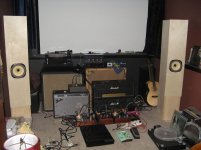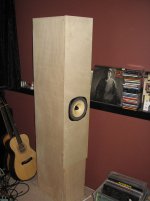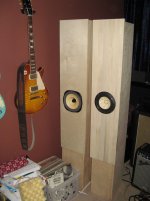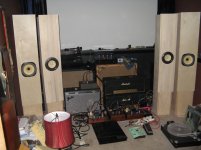Wow, all I can say is that the Lowther Drivers are worth every penny. They only have an hour of play time on them and they're clearly better than the Fostex 168 sigmas that I built a few weeks ago. The presentation is more full, clear, crisp, and lifelike. Sounds like a curtain was in front of the Fostex drivers.
Here are a few pics. Excuse my mess but I'm revamping my entire system and need to get rid of stuff. As it is I'm doubled up on amps and speakers. Now that I've got the SET/horn bug, the traditional stuff will have to go. Thanks again to Zilla for his BIB site and Scottmoose for the dimensions. Up next is the Sachiko. I can't wait to hear what the Lowthers will be like in that enclosure. 🙂
Here are a few pics. Excuse my mess but I'm revamping my entire system and need to get rid of stuff. As it is I'm doubled up on amps and speakers. Now that I've got the SET/horn bug, the traditional stuff will have to go. Thanks again to Zilla for his BIB site and Scottmoose for the dimensions. Up next is the Sachiko. I can't wait to hear what the Lowthers will be like in that enclosure. 🙂
Attachments
Nice work and thanks for the comparison between the two drivers. Looking forward to your comparison to a horn.
True, but then, what else could you call it from a technical POV Martin? Not trying to be pedantic, just curious. The BIB is a closed cone, or approximates one anyway, as it expands toward the mouth (unlike a TQWT, which is reverse tapered), and in practice is a 1/2 wave resonator with a 1/4 wave fundamental. That's pretty much the definition of a horn TTBOMK.
My definition of a horn includes the size of the mouth, in my way of thinking a horn's mouth completely damps the potential standing waves. For bass this means the effective mouth needs to be very big. My definition of a horn does not include resonances as an action that produces sound. A BIB relies on resonances to reinforce the bass, so to me it is a varient of a TL.
Scottmoose said:and in practice is a 1/2 wave resonator with a 1/4 wave fundamental.
If one end is open and the other end closed, I think you can only have quarter wave resonances. I am not sure how a half wave resonance shape can be supported by this geometry.
Ah, I see where you're coming from now Martin. Sorry about that.
Well, I can't argue the physics with you, as I'm somewhat limited in that regard. However, WRT the 1/2 wave side of things, what I was trying to say (badly) is that a conical air column should have the same fundamental & harmonic behaviour as that of an open cylinder. At least, so I've always been led to believe: http://hyperphysics.phy-astr.gsu.edu/hbase/waves/opecol.html
Following that line, my take is that horn action is defined to a great extent by this. If we use your prefered definition of mouth-size, then TC's first box, as an example, should have a decent impedance-match at the mouth down to ~133Hz once corner loaded, & from my POV maintain 1/2 wave resonance (which I would call horn action) to roughly 49Hz, with 1/4 wave action supplying the bottom octave down to the final 24.5Hz cutoff. That's assuming I'm not loosing it in a major way of course, which has been known. 😉 Frequently.
Anyway, I take your point -people tend to apply different definitions to words. Look at the fracas over TL. Bailey has much to answer for with that one. Title was great (& made perfect sense with the TL phrase). Article was interesting. Problem was, the title didn't actually describe the body of the text very well. Groan.
Well, I can't argue the physics with you, as I'm somewhat limited in that regard. However, WRT the 1/2 wave side of things, what I was trying to say (badly) is that a conical air column should have the same fundamental & harmonic behaviour as that of an open cylinder. At least, so I've always been led to believe: http://hyperphysics.phy-astr.gsu.edu/hbase/waves/opecol.html
Following that line, my take is that horn action is defined to a great extent by this. If we use your prefered definition of mouth-size, then TC's first box, as an example, should have a decent impedance-match at the mouth down to ~133Hz once corner loaded, & from my POV maintain 1/2 wave resonance (which I would call horn action) to roughly 49Hz, with 1/4 wave action supplying the bottom octave down to the final 24.5Hz cutoff. That's assuming I'm not loosing it in a major way of course, which has been known. 😉 Frequently.

Anyway, I take your point -people tend to apply different definitions to words. Look at the fracas over TL. Bailey has much to answer for with that one. Title was great (& made perfect sense with the TL phrase). Article was interesting. Problem was, the title didn't actually describe the body of the text very well. Groan.

Nice work Gnugear, How's the bass with the Lowthers in the BIB's? Sounds like the Lowthers are worth those extra $$$ I wonder how an AER in the BIB would compare? Dave🙂
Scott and MJK, they sound great for the ease of build whatever they are😀
Scott and MJK, they sound great for the ease of build whatever they are😀
If you look at the mode shapes of the cone in the link you posted, they would appear to be multiples of quarter waves. A maximum (or close enough to a maximum) is seen at the large open end, if it were a closed end then half wave action would be seen and the plots would exhibit a null at the large end.
For me a horn is a device that increases the efficiency of the driver over a broad band of frequencies, this is accomplished by better transfer of energy into the room instead of reflecting it back into the expanding enclosure geometry. This means that the acoustic impedance at the open end needs to be primarily resistive at the frequencies of interest, this is determiend by mouth size and shape. If efficient energy transfer exists, then standing waves are suppressed (damped).
For the BIB design, the mouth is small compared to the bass frequencies that are being reproduced even if it stands in a corner. This means that the pipe is resonating and the resulting efficient bass output occurs only over a narrow bandwidth, like an unstuffed TL. You will still get harmonics of the fundamental that will produce efficient SPL bands emitting from the mouth of the BIB pipe. At some higher frequency the mouth impedance will become resistive and according to my proposed definition horn like behavior will result. Most back loaded horn designs work in this way, TL action at low frequencies transitioning to horn like behavior at higher frequencies (say between 200 and 300 Hz) and then using a coupling chamber to roll off the back loaded horn's output.
Repeating my definition, a horn is a device that increases the output efficiency of a driver over a broad range of frequencies, the requirement for this to occur is an adequately sized mouth. If the mouth is too small energy is reflected back towards the driver and standing wave resonances will exist. Standing wave resonances are easily seen in the impedance plot of the speaker, multiple peaks mean multiple resonances. A single well damped peak at the tuning frequency of the system is a good indication of a well designed horn. That is my opinion and definition, a maker of a popular commercial back loaded horn does not agree and will loudly tell you flat out I am full of $hit, so be it. But no matter which definition suits you, in all cases the standing waves are quarter wavelength in shape.
For me a horn is a device that increases the efficiency of the driver over a broad band of frequencies, this is accomplished by better transfer of energy into the room instead of reflecting it back into the expanding enclosure geometry. This means that the acoustic impedance at the open end needs to be primarily resistive at the frequencies of interest, this is determiend by mouth size and shape. If efficient energy transfer exists, then standing waves are suppressed (damped).
For the BIB design, the mouth is small compared to the bass frequencies that are being reproduced even if it stands in a corner. This means that the pipe is resonating and the resulting efficient bass output occurs only over a narrow bandwidth, like an unstuffed TL. You will still get harmonics of the fundamental that will produce efficient SPL bands emitting from the mouth of the BIB pipe. At some higher frequency the mouth impedance will become resistive and according to my proposed definition horn like behavior will result. Most back loaded horn designs work in this way, TL action at low frequencies transitioning to horn like behavior at higher frequencies (say between 200 and 300 Hz) and then using a coupling chamber to roll off the back loaded horn's output.
Repeating my definition, a horn is a device that increases the output efficiency of a driver over a broad range of frequencies, the requirement for this to occur is an adequately sized mouth. If the mouth is too small energy is reflected back towards the driver and standing wave resonances will exist. Standing wave resonances are easily seen in the impedance plot of the speaker, multiple peaks mean multiple resonances. A single well damped peak at the tuning frequency of the system is a good indication of a well designed horn. That is my opinion and definition, a maker of a popular commercial back loaded horn does not agree and will loudly tell you flat out I am full of $hit, so be it. But no matter which definition suits you, in all cases the standing waves are quarter wavelength in shape.
Oh, I agree about the BIB not being optimal Martin. Very little is. Even the Kleinhorn relies on a degree of 1/4 wave action to prop up the LF as its terminus is under-sized, & I understand all of what you have mentioned (probably better than you realise -we're actually on the same wavelength here I think).
What I was attempting to say above was simply that whereas the length of a closed cylinder equates to lambda / 4, a closed cone, like an open cylinder, typically will be lambda / 2, although it will retain the classic 1/4 wave fundamental with displacement node / pressure antinode at the sealed end etc. Hence my remark about a cone being a 1/2 wave resonator with a 1/4 wave fundamental. I'm probably a little loose with my defintion, which is that any positively expanding pipe is a horn (irrespective of whether the terminus is optimally sized or not...) but I suppose we all have our sins. 😀 I believe GM has a similar take on it, so at least I'm not completely alone in my insanity.
Proves one thing though: definitions can be a complete PITA.
What I was attempting to say above was simply that whereas the length of a closed cylinder equates to lambda / 4, a closed cone, like an open cylinder, typically will be lambda / 2, although it will retain the classic 1/4 wave fundamental with displacement node / pressure antinode at the sealed end etc. Hence my remark about a cone being a 1/2 wave resonator with a 1/4 wave fundamental. I'm probably a little loose with my defintion, which is that any positively expanding pipe is a horn (irrespective of whether the terminus is optimally sized or not...) but I suppose we all have our sins. 😀 I believe GM has a similar take on it, so at least I'm not completely alone in my insanity.
Proves one thing though: definitions can be a complete PITA.
DaveCan,
Thanks! The bass seems on par with the Fostex drivers. I've heard they'll flesh out more once they're broken in so we'll see what happens. In any event I use a sub to fill in the bottom, so bass was never an issue.
Thanks! The bass seems on par with the Fostex drivers. I've heard they'll flesh out more once they're broken in so we'll see what happens. In any event I use a sub to fill in the bottom, so bass was never an issue.
Gnugear,
You are going through builds like crazy. Neat.
If your fronts are removable can you show interior treatment?
Or describe it?
My latest satisfactory tweak was adding a piece of billiard felt behind the driver. Along with that just the peak is stuffed pretty tight and the floor of the interior has a loose inch of fiberfil.
Also just completed a flush mount. All this for the FE127e.
You are going through builds like crazy. Neat.
If your fronts are removable can you show interior treatment?
Or describe it?
My latest satisfactory tweak was adding a piece of billiard felt behind the driver. Along with that just the peak is stuffed pretty tight and the floor of the interior has a loose inch of fiberfil.
Also just completed a flush mount. All this for the FE127e.
Here's a pic of the insides. I messed around a lot with my Fostex BIB until I got it to sound right so I did the same to these before I glued it shut. I just stapled the wool blanket in place so it's prety easy to remove.
I also used this new stuff I found at the fabric store called bamboo fiber filler. Don't laugh, but when I shouted into the bag it seemed to damp the sound much better than the regular polyfil. It's super soft and fluffy.
I also used this new stuff I found at the fabric store called bamboo fiber filler. Don't laugh, but when I shouted into the bag it seemed to damp the sound much better than the regular polyfil. It's super soft and fluffy.
Attachments
There seems to be more bamboo stuff around: this fiber stuff, speaker cones and plywood too. I wonder how common the bamboo filler is?
The quilting section of Jo Ann Fabrics around here seemed to be getting cleaned out the last time I was in... slim pickings for remainders which is what I look for-- roll ends and so on.
For those who still want to use fiber glass, I found that sold in small bags at Home Depot. It's sold to pack around utility boxes between joists.
Something much cleaner like the bamboo seems ideal.
The quilting section of Jo Ann Fabrics around here seemed to be getting cleaned out the last time I was in... slim pickings for remainders which is what I look for-- roll ends and so on.
For those who still want to use fiber glass, I found that sold in small bags at Home Depot. It's sold to pack around utility boxes between joists.
Something much cleaner like the bamboo seems ideal.
- Status
- Not open for further replies.
- Home
- Loudspeakers
- Full Range
- Finished my second BIB. This time Lowther DX3




